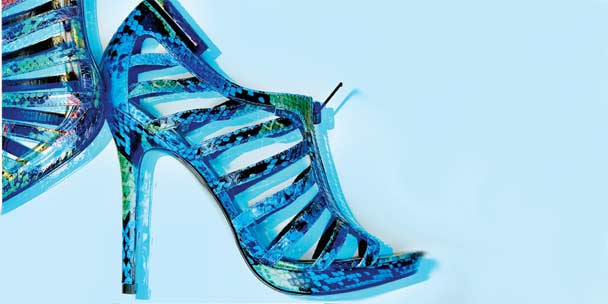Health & Fitness
The last stand: Why your shoes could be damaging your toes
Stamp out foot pain for good with the latest treatments and friendly footwear.
by : Kristen Vinakmens- May 14th, 2009

One of the best things about summer is trading in our heavy winter boots for stylish, strappy shoes. But those pretty little sandals are doing a number on our feet. Wearing them for long periods of time can cause arch and heel pain and heel spurs (little bony growths on your heels). An increasing number of women are finding themselves at the podiatrist due to foot pain from ill-fitting footwear. But there are solutions, from shoe inserts and “friendly” footwear to shock therapy and surgery.
FootWork
Your feet go through a lot in your lifetime: You’ll walk about 113,000 kilometres and take roughly 15,000 steps a day. What’s more, your feet will absorb over one million pounds of force on a daily basis. “At some point in our lives, every one of us will develop foot or ankle problems,” says Robert Chelin, a podiatrist based in Toronto and president of the International Federation of Podiatrists. But the issue is more profound among women, he says. Women are leading more active lifestyles, working longer hours and working out, which puts added pressure on their feet. And let’s not forget the fashion side of it: High heels, narrow toes, tight straps and ballerina flats with no support are just a few of the potential threats.
Some foot problems are beyond our control. We have genetics to thank for conditions like flat feet (low arches), bunions (a bony enlargement of the joint in the big toe) and unsightly corns. Lifestyle choices and day-to-day
activities, such as running on concrete sidewalks or standing on hard floors all day long, can lead to a condition known as plantar fasciitis. Especially common among athletes, it happens when the ligament between your heel bone and the ball of your foot becomes strained and inflamed. Plantar fasciitis is the most typical cause of heel pain, and it can linger for weeks.
SIZE MATTERS
It’s simple: If your shoes don’t fit properly, they will damage your feet. An ill-fitting shoe can cause everything from corns and blisters to heel pain and clawing or curling of the toes. Foot shape varies among individuals, and one shoe design may not suit everyone — arches may be a different height, or the same person may have two different-sized feet. “Your shoe size may change, as feet swell during the course of the day,” says Chelin. He recommends buying shoes at the end of the day (when your feet are at their maximum size) and getting your feet measured, if possible. “Buy shoes that fit, and don’t worry about the number.”

PUMPED UP
Wearing high heels can hurt, but vanity and our love of fashion usually win out over discomfort. It’s one thing to go from a taxi to the dinner table sporting to-die-for heels and another to run for the bus on the way to the office. So, what’s the problem with rushing around town in Louboutins? “Stilettos put excessive pressure on the ‘balls’ of your feet,” says Julie Giroux, a pedorthist with the Women’s College Hospital Foot Care Centre in Toronto. “And they often have very narrow, tapered toes, which force your feet into an unhealthy position.” Shoes that are too narrow can lead to a condition called hammertoe, in which the end of your toe is bent downward.
It’s not so much the heels themselves as our abuse of them that leads to problems. “You can’t wear heels for five kilometres and expect to feel comfortable,” says Dr. Suzanne Levine, a podiatric surgeon based in New York, who has made it her mission to keep Manhattan’s elite in their Manolos. At her New York clinic, she offers a treatment called Stiletto Rx: Pillows for Your Feet, a series of polylactic acid injections that plump up the footpads. “As you age, you lose all that natural cushioning,” says Levine. The treatments last anywhere from six to nine months, and patients can “run around immediately” after the procedure. Levine is also developing a shoe called the Stiletto Rx, which will launch this fall. The stiletto is made with silicone cushioning and designed with the style sense of a Jimmy Choo shoe.
While Giroux says that the ideal heel height is a mere two centimetres or less, practising moderation is key for women with a love for leg-lengthening stilettos. Varying heel heights can help take pressure off the balls of the feet, says Levine. Alternate your pumps with more functional shoes, such as running shoes, and give your feet a break.
FOOTLOOSE
One of the worst things you can do to your feet is wear flip-flops — especially on city streets. Chelin describes these sandals as a “danger waiting to happen” due to their lack of support, protection and
stability. “They’re not meant to be anything more than a beach shoe,” he says. Some of the issues you might encounter if you wear flip-flops all summer long are heel pain (caused by lack of arch support) and ankle, knee and back pain. A study from Auburn University in Alabama found that walking in flip-flops changes our gait, requiring us to overcompensate: We strike the ground with less force and grip shoes with our toes to hold on.

TREATMENT OPTIONS
In an ideal world, we would all have custom footwear, says Chelin. But
you can enhance shoes with arch-support inserts or orthotics. “Orthotics alter how your feet function to reduce pain and potentially slow down deformity,” says Giroux. Off-the-shelf inserts — available from specialists and pharmacies — can be a solution for those with mild foot problems who may need added cushioning or arch support and come in a range of sizes and supports. If you have an unusual foot shape or severe foot pain, custom insoles — in which a mould is taken of the feet — might be the answer. A foot-care specialist, such as a pedorthist, can assess whether orthotics are right for you. Orthotics typically cost about $450.
Most foot problems are remedied without surgery, but if the pain is severe and you’re unable to find the right footwear, you may be a good candidate, says Johnny Lau, an orthopaedic surgeon at the University Health Network at the University of Toronto. Common surgeries include treating bunions, Achilles tendinitis (inflammation of the Achilles tendon caused by overtraining) and claw toes. h Procedures usually involve removing the offending bone or tissue and can require at least six weeks of healing time.
New treatments are offering alternatives to surgery. Neuromas, or pinched nerves caused by tight toe boxes or excessive activity, can be treated with minimally invasive injections of a sclerosing agent, which kills the vessels that feed the diseased nerve and ultimately the nerve itself. “We are seeing a lot of neuromas in women who exercise or use an elliptical trainer,” says Levine. “They’re putting four times their body weight on their forefoot.”
For those who are suffering from plantar fasciitis, shockwave treatments may be the solution. Devices use high- or low-energy shockwaves to create microfractures in the inflamed region to stimulate healing. These treatments are generating excitement due to their success rate. “Trials have demonstrated 80 percent relief for some people,” says Lau. Levine is also using the high-energy machine to treat bunions. Rather than removing the bunion itself, the treatments remove the inflammation.
WARNING SIGN
If you’re suffering from chronic foot pain, see your doctor. “Your biomechanics could be off,” says Lau. “You could be pronating or rolling in.” Persistent tingling or numbness in your feet can also be a sign of other health problems, such as diabetes, says Giroux, so have it checked out as soon as possible. If you’re suddenly working out a lot more than usual and experiencing foot pain, the answer is simple. “Reduce your activity to alleviate the pain,” says Lau. If the problem persists after you stop training or if you can’t put weight on your foot, see your family doctor, who can do an X-ray to rule out if something is broken.
FOOTNOTES
When it comes to our feet, prevention is the best cure of all. Levine stresses the importance of strengthening your foot muscles through exercise. “Our feet are kept in shoes all day, so these muscles aren’t strong,” she says. Doing simple exercises a few times a week, such as rolling a tennis ball back and forth with your foot 50 times or writing the alphabet with your toes, can help stabilize your foot muscles. “Feet are the foundation of your body,” adds Chelin. “As long as you keep the foundation stable and balanced, the rest of the structure will stay reasonably stable too.”
Newsletter
Join our mailing list for the latest and biggest in fashion trends, beauty, culture and celebrity.
Read Next

Fashion
H&M's Latest Designer Collab With Rokh Just Dropped (And It's So Good)
We chatted with the emerging designer about the collaboration, his favourite pieces and more.
by : Melissa Fejtek- Apr 18th, 2024

Culture
5 Toronto Restaurants to Celebrate Mother’s Day
Treat your mom right with a meal at any of these amazing restaurants.
by : Rebecca Gao- Apr 18th, 2024

Culture
This University Elevates Women to New Professional Heights
You shouldn’t have to pause your life to move forward in your career.
by : ELLE Canada- Apr 16th, 2024


